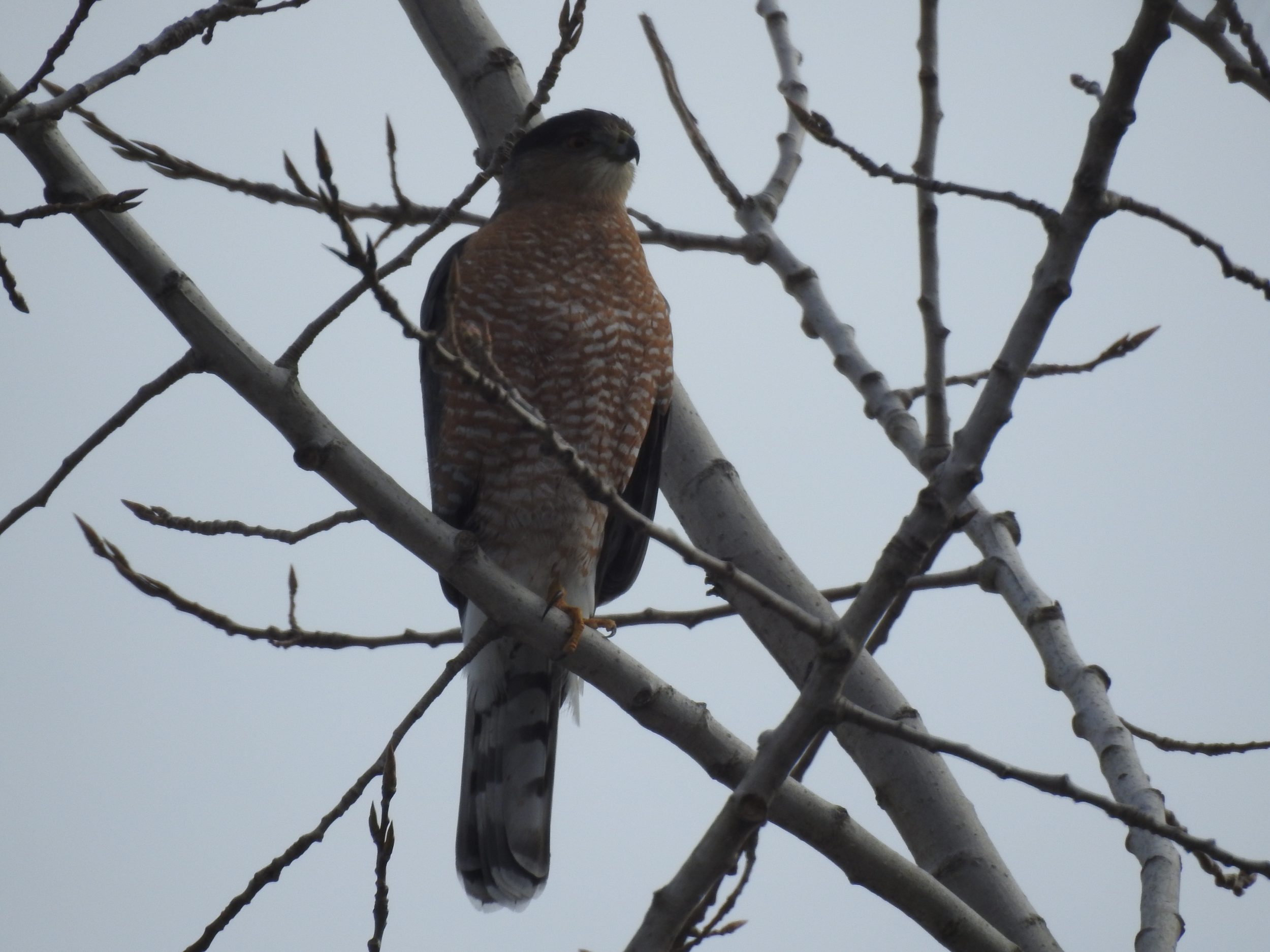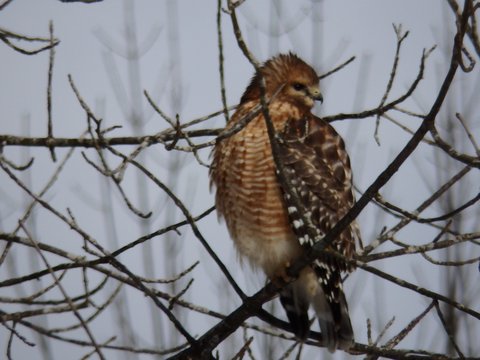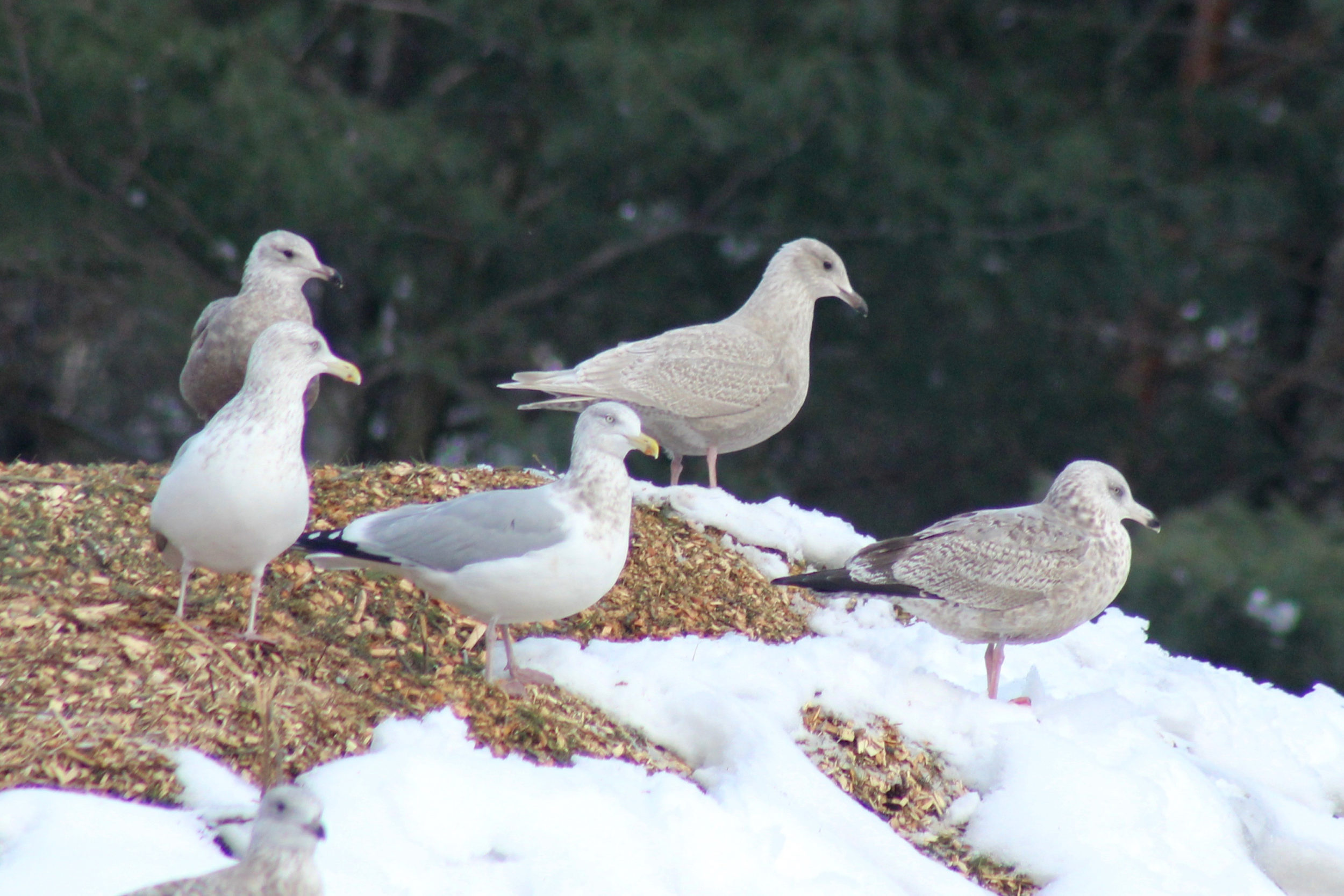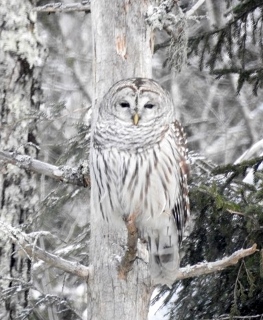The Christmas Bird Count (CBC) season has come to an end and as we warm our frozen extremities and dream of spring birding, it’s time to revel in what has been counted. Here is summary of what was tweeting (no, not that kind of tweeting), hopping, and flying through Vermont count circles during the 118th Christmas Bird Count. Our apologies for not getting results from all the counts just yet; we will keep this page updated as they come in.
Birders on the Barnet count braved temperatures of -26°F on the first of the year. They counted 2,845 individuals and 38 species. With high counts of 6 Red Crossbills and 433 Dark-eyed Juncos and low counts of 1 Red-tailed Hawk, 302 Black-capped Chickadees, and 33 House Sparrows. An unusual find on the Barnet count was one Rusty Blackbird.
The Bennington count tallied 6956 individuals of 50 species. Like the Barnet count (and many other counts, as you will later read), Bennington also noticed a big decline in Black-capped Chickadee numbers to an unusual low of 139. A high count of 131 White-throated Sparrows was documented, and a Snowy Owl sighting was a count highlight.
The Brattleboro count occurred for the 57th year and despite snow and cold participants racked up 4,742 individual birds and 50 different species. Some particularly exciting finds included the first Baltimore Oriole in the history of the Brattleboro count, the first Gray Catbird to be seen on the Brattleboro count in a decade, and the first Red-winged Blackbird in 8 years. Low waterfowl numbers were observed – perhaps due to limited open water on the West and Connecticut rivers – with the exception of 156 Mallards and 754 Canada Geese, the largest number of Canada Geese since 2008. Like the Barnet count, the Brattleboro count saw a high number of Dark-eyed Juncos, with 632 making it the highest total for the species since 2000. While the total number of species counted in Brattleboro represented an 8% decline from the ten-year average, the number of individuals counted for the Brattleboro CBC was about 17% higher than the past ten-year average, and 23% higher than the thirty-year average.
The final tallies for the 70th Burlington count are still being compiled, however, current numbers stand at 17, 516 individuals of 70 different species. Previous record numbers of 1 Golden Eagle, 9 Cooper’s Hawks, 1 Northern Saw-whet Owl, 1 Yellow-Bellied Sapsucker, and 1 Fish Crow were met this year. All-time highs were 4, 930 Greater and Lesser Scaup, 28 Red-Bellied Woodpeckers, 10 Northern Flickers, 2 Merlin, 4 Peregrine Falcons, 35 Common Raven, 835 Dark-Eyed Junco, 26 White-throated Sparrow, and 2 Turkey Vultures.
In the Champlain Islands and St. Albans, counters recorded a total of 11,603 birds – up from 9,134 individuals last year – and 58 count-day species. Great Horned Owl and Snowy Owl sightings were also noted during count week. Ten Bald Eagles marked a new high for the count and a Savannah Sparrow sighting was a count first. Participants noted a marked decrease in American Robins with only 13 recorded down from 569 in 2016.
In East Franklin County, counters recorded 4,263 individual birds of 34 total species. High counts included 139 Mallards, 10 Ruffed Grouse, 6 Bald Eagles, 619 Blue Jays, 3 Golden-crowned Kinglets, 20 Northern Cardinals, and 7 White-winged Crossbills. Low counts included 22 White-breasted Nuthatches and 72 Wild Turkeys, and like some of the other Vermont counts, observers found relatively low numbers of Black-capped Chickadees at 423 individuals.
The 58th Ferrisburgh Christmas Bird Count racked up 78 species and 23,365 individuals. Relatively rare species for the count included the first Red Crossbills observed since 2004 and two Red-shouldered Hawks seen only twice previously in the history of the count. Additional rarer species numbers were 10 Gadwall, 2 Snowy Owls, 23 Yellow-rumped Warblers, 1 White-crowned Sparrow, and 1 Ruby-crowned Kinglet. Black-capped Chickadees were found in unusually low numbers with 579 making it the lowest number of individuals since 1979. A record high number of European Starlings were recorded a 5,406, beating the previous record of 5,137 birds recorded in 2011. Seventeen species were found by all of Ferrisburgh field teams: Canada Goose, Red-tailed Hawk, Rock Pigeon, Mourning Dove, Blue Jay, Common Raven, American Crow, Black-capped Chickadee, Tufted Titmouse, White-breasted Nuthatch, European Starling, Northern Cardinal, Dark-eyed Junco, American Tree Sparrow, House Finch, American Goldfinch, and House Sparrow. Ten species were found by only one group: Red-throated Loon, Greater Scaup, Ring-necked Pheasant, Red Crossbill, Ruby-crowned Kinglet and White-crowned Sparrow, Brown-headed Cowbird, American kestrel, Merlin, and Short-eared owl.
The Hanover-Norwich CBC marked a 21st century low at 45 species with six
additional during count week and 7036 individuals. The last time the count reached a low of 45 species count was in 1999. A hen Greater Scaup found on the Connecticut River marked a new count day species, and new count highs were established for Dark-eyed Junco (1888 individuals), White-throated Sparrow (74 individuals), and Yellow-bellied Sapsuckers (2). Chickadee numbers at 393 individuals were down, at their lowest level since 1984. An exciting find was the third count record of Ruby-crowned Kinglet and the first record of the species since 1995.
This year marked the second year of the Hunger Mountain count and a very successful one at that – with 11 new species added from last year. The final tally rang in at 3, 511 individuals of 47
species. For the second year in a row, Glaucous and Iceland gulls were found at GROW Compost. Of the new species added, several were unusual or uncommon for central Vermont including Pied-billed Grebe, Rough-legged Hawk, Peregrine Falcon, and Eastern Bluebird. A Hunger Mountain highlight was a Baltimore Oriole sighting at a feeder in Duxbury. Consistent with other count circle observations, Black-capped Chickadee numbers were down – only 380 down from 847 in the previous year – while Dark-eyed Juncos were up – 482 versus 70 in the previous year
The Island Pond count reported 684 individuals of 32 total species, up from 23 species reported last year. Increases from the previous year included Blue Jay numbers at 144 up from 26, 38 American Goldfinches up from 2, and 25 White-winged Crossbills which were not observed at all in 2016. At 124 individuals recorded, Black-capped Chickadee numbers were about half of those observed in 2016.
The Mad River Valley/Northfield count noted a similar number of individuals as previous years – 3,058 birds compared to the average of 3,679 – but a record low for number of species, with 36 species observed on count day plus 2 more during count week. Bird highlights include the first sighting of a Merlin and a Wilson’s Snipe in the history of the count circle. A human highlight was the attendance of a birder from Albany, NY who ventured east in order to participate in ten Christmas Bird Counts this year!

Birders on the Mad River Valley/Northfield CBC demonstrate good birding safety with their marked vehicle. Photo: Mad Birders
The Middlebury count saw no shortage of birds with 15,963 individuals from 72 species, high counts of 7 species and 8 unusual species were noted. High counts included 14 Cooper’s Hawks, 6 Yellow-bellied Sapsuckers, 435 Blue Jays, 833 Dark-eyed Juncos, 4 White-crowned Sparrows, 168 White-throated Sparrows, and 23 Savannah Sparrows. Unusual species counts were 2 Black Vulture, 1 Long-eared Owl, 1 Brown Thrasher, 1 Common Yellowthroat, 1 Chipping Sparrow, 1 Field Sparrow, 1 Rusty Blackbird, and 1 Red Crossbill.
The Mt. Abraham count located 53 species. A Snowy Owl at Bristol Pond was an unusual surprise for Mt. Abraham counters, as well as 2 American Kestrels and 1 Merlin also added on count day. The count located a high number of Dark-eyed Juncos at 170 and a low of 3 Wild Turkeys. Two count week species were a Northern Shrike, and 2 Blue-winged Teal in a large group of Mallards.
Counters in Plainfield noted 42 species plus Carolina Wren during count week. Species of particular note were the first Northern Harrier observed in 57 years of the Plainfield CBC. An all-time high of 402 Dark-eyed Juncos were also recorded, up from 22 observed the previous year. Other increases included 40 Golden-crowned Kinglets up from 7 in 2016, 245 American Goldfinches up from 88, and 36 Purple Finches, which were not observed in the previous year.
The Randolph count reported 30 species and 1379 individuals. There were no high counts or low counts reported for this count circle. But while the count did not report a record high of Dark-eyed Juncos, they did record a respectable number of Juncos per party hour, with 17 individuals recorded per party hour. This put Randolph’s individual Juncos per party hour above that of Barnet, East Franklin County, Hinesburg, Island Pond, Middlebury, and Plainfield. Other interesting sightings include 1 Sharp-shinned Hawk and 6 Common Redpolls, both of which were not seen in the previous year.
Counters in Saxton’s River noted 9,461 individuals of 60 different species with a high count of 58 Eastern Bluebird and an unusual species in one Black Vulture.
The Springfield count tied their all-time high for number of species at 56 and added a count week species, beating their ten-year average of 49 species. Three new count species included a Turkey Vulture, a Wood Duck, and seven Red Crossbills. The total number of individuals of 7,110 was lower than the count’s ten-year average of 7,465. This may have been partially explained by a lack of northern migrants like Snow Bunting, Pine Siskin, Pine Grosbeak, and Horned Larks. Also noted in low numbers were American Goldfinch at 243 and Black-capped Chickadees at 598. Record high numbers for the Springfield count included 9 Bald Eagles, 21 Red-Bellied Woodpeckers, 133 White-Throated Sparrows, and . . . 1,900 Juncos!
With a few feeder counts still to be entered, the 43rd year of the Woodstock count saw 40 species plus 2 during count week and 2,914 individuals which are both above average numbers for the count. Low Black-capped Chickadee numbers were recorded but record highs were observed for Dark-eyed Juncos (526) and White-throated Sparrows (15). Unusual count species included Bald Eagle, Yellow-bellied Sapsucker, Red bellied Woodpecker, Hermit Thrush, Red-winged Blackbird, and Red Crossbill.
Some highlights from the Winhall/Windham area count were a Barred Owl sighting and 11 Red Crossbills. Red Crossbills were an unusual species for the count, having only been recorded at 9 out of Winhall/Windham’s 51 CBCs. A high count of 527 Dark-eyed Juncos and a low count of 134 Black-capped Chickadees was recorded. This was an all-time low for the Winhall/Windham count and is especially striking when compared to the counts all-time high of 905 Black-capped Chickadees in 1989.
The results from the Hinesburg-Huntington, Lamoille County, Plattsburgh (NY), Randolph, and Rutland counts will be updated as they come in. Until then, Happy New Year and may the birding Force be with you.
More Information:
- We encourage you to add your observations to Vermont eBird. Check out this short article about helpful hints.
- See an interactive map of all the CBC counts.
- To view and explore results from this year (as data becomes available) and past CBCs, visit this online portal.




